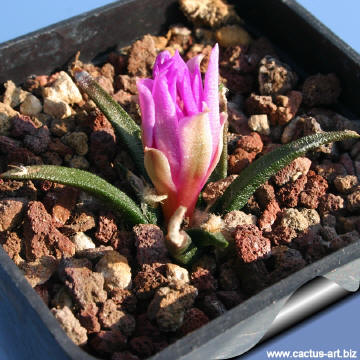|
|
|

Ariocarpus agavoides var. sanluisensis
The uncommon characteristic of this rare population is the presence of
spines in the areoles.
|
|
Description: The peculiarity of the "sanluisensis"
variety is the presence of spines in the areoles, this characteristic is
sometime found also in the plant from Tula (even if very rare), while
most of the plant from San Luis Potosi are spiny.
The plants from the different known populations are anyhow very similar,
the only noticeable difference is the presence of spines, while flowers,
tubercles and size are identical.
Stem: Greenish-brown
sub-globose, flattened on top, 2-6cm high, rising barely above
ground level, 4-8cm in diameter.The rest of the plant (swollen
rootstock) stay
underground.
Tubercles: Divergent, often flaccid and not
erect, not crowded or
basally compressed,
acute at the
apices, flattened
adaxially, not
fissured, not incurved, 3-7cm long, 5-10mm broad, more than 4 times
as long as wide;
Areoles: 5-12mm from the tips of the tubercles, rounded, 2-5 mm in
diameter;
Spines: None or up to 3, 2-6 mm long, whitish.
Flowers: 3.5-4.2cm in diameter, 2-5cm long; outer
perianth segments magenta with greenish-white
margins, inner perianth parts deep magenta,
pistil 2-3mm above the
stamens;
style white. 1-2cm long;
stigmas 5-8, 1-2.5mm long;
Fruit: pinkish-red to reddish purple,
globose to
elongate, 10-20mm long, 5-12mm in diameter.
|
|
 |
 |
|
. |
 |
 |
|


Advertising
|
|
|
|
|
Family:
Cactaceae (Cactus
Family)
Conservation status: Listed in
CITES appendix I
Scientific name: Ariocarpus agavoides var. sanluisensis
Sotom.
Arred., Sanchez Barra & Mart.Mend.
Origin: Mexico, The
type locality of A. agavoides is sited around the town of Tula, Tamaulipas. Two new
colonies have been found recently in San Luis Potosi, disjunct from
the original site (A. agavoides var. sanluisensis).
Synonyms:
Ariocarpus agavoides f. san-luisensis

|
|
|
|

Cultivation: Grows in
alluvial plain that becomes muddy in
summer, so likes quite a lot of water then... but very
prone to rot other times of the year,
give moderate water in
spring and
autumn, no water in
winter. Cultivate it in a well drained, non-organic,
free-draining soil compost. The use of a weak low-nitrogen fertilizer
during the growing season can encourage growth. The main threat to
its development is root rot.
The Ariocarpus should be kept dry whenever there is a threat of
cold. The appearance of Ariocarpus can benefit greatly by watering
the plants from the bottom. This practice will help to keep the
“wool” on the top of the plant from becoming matted or discoloured.
Need
half shadel to
Full sunf. Frost Tolerance: Hardy to -10° C.
Propagation: It is easy to
raise from seed, but will generally take about 5-8 years to reach
flowering size, occasionally grafted.
Photo of conspecific taxa, varieties, forms and
cultivars of Ariocarpus agavoides:.
|
|